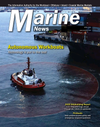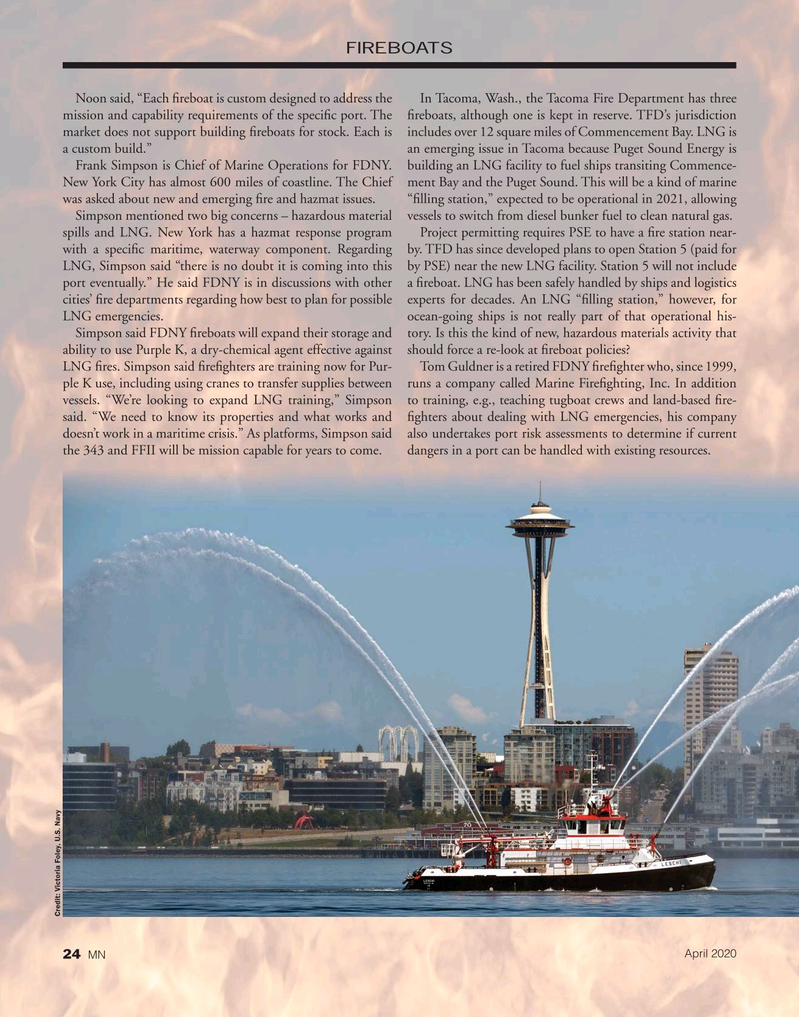
Page 24: of Marine News Magazine (April 2020)
Autonomous Workboats
Read this page in Pdf, Flash or Html5 edition of April 2020 Marine News Magazine
FIREBOATS
Noon said, “Each ?reboat is custom designed to address the In Tacoma, Wash., the Tacoma Fire Department has three mission and capability requirements of the speci?c port. The ?reboats, although one is kept in reserve. TFD’s jurisdiction market does not support building ?reboats for stock. Each is includes over 12 square miles of Commencement Bay. LNG is a custom build.” an emerging issue in Tacoma because Puget Sound Energy is
Frank Simpson is Chief of Marine Operations for FDNY. building an LNG facility to fuel ships transiting Commence-
New York City has almost 600 miles of coastline. The Chief ment Bay and the Puget Sound. This will be a kind of marine was asked about new and emerging ?re and hazmat issues. “?lling station,” expected to be operational in 2021, allowing
Simpson mentioned two big concerns – hazardous material vessels to switch from diesel bunker fuel to clean natural gas.
spills and LNG. New York has a hazmat response program Project permitting requires PSE to have a ?re station near- with a speci?c maritime, waterway component. Regarding by. TFD has since developed plans to open Station 5 (paid for
LNG, Simpson said “there is no doubt it is coming into this by PSE) near the new LNG facility. Station 5 will not include port eventually.” He said FDNY is in discussions with other a ?reboat. LNG has been safely handled by ships and logistics cities’ ?re departments regarding how best to plan for possible experts for decades. An LNG “?lling station,” however, for
LNG emergencies. ocean-going ships is not really part of that operational his-
Simpson said FDNY ?reboats will expand their storage and tory. Is this the kind of new, hazardous materials activity that ability to use Purple K, a dry-chemical agent effective against should force a re-look at ?reboat policies?
LNG ?res. Simpson said ?re?ghters are training now for Pur- Tom Guldner is a retired FDNY ?re?ghter who, since 1999, ple K use, including using cranes to transfer supplies between runs a company called Marine Fire?ghting, Inc. In addition vessels. “We’re looking to expand LNG training,” Simpson to training, e.g., teaching tugboat crews and land-based ?re- said. “We need to know its properties and what works and ?ghters about dealing with LNG emergencies, his company doesn’t work in a maritime crisis.” As platforms, Simpson said also undertakes port risk assessments to determine if current the 343 and FFII will be mission capable for years to come. dangers in a port can be handled with existing resources.
Credit: Victoria Foley, U.S. Navy
April 2020 24 MN

 23
23

 25
25
